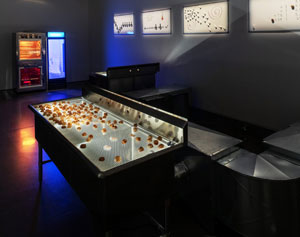The Queens Museum will always have its building and its memories—the New York City pavilion at the 1964 World’s Fair, with the marvelous scale model of the city inside. Yet it would be only a pale reminder of past glories without art.
On a cold winter’s day in midweek, the fair’s Unisphere right out front had no one to appreciate it, and water did not run in the pool beneath. The tennis center from the U.S. Open stood towering and empty just a glance away, and the walk to the subway through Flushing Meadow Park felt lonely and bleak. Grand Central Parkway running past the museum’s entrance seemed to cut it off once and for all from the Latin American neighbors that it so often celebrates in its art, but bundle up. With four shows through April 7, the museum welcomes emerging artists all the same and to keep things light—and I work this together with a recent report on the clamor and cacophony of “Open Call 2023” at the Shed as a longer review and my latest upload.
Besides, there are worse things than art, especially in a museum, and these four seemed determined to stay optimistic. That is not exactly a compliment, but it beats the winter blues. The curved wall facing the exhibition space always has its charms. Who would not want a new mural on that scale every few months? Still, most often, one can easily ignore it on the way to the model city, with its spare curves in black and white. Not this time.
Caroline Kent announces her modesty along with her ambitions in its title, A short play about watching shadows move across the room. Still, those shadows are colorful, and they almost dance. They are also in high relief, carrying them into the space of the museum, and Kent claims to draw on floor plans for the site as well. I could not see a design, but its lightness against a black background does come as a relief. It also segues easily into more art that takes off from the wall.
sonia louise davis is anything but confrontational, much like her title, to reverberate tenderly. And she means “reverberate” seriously. She considers her free-form sculpture musical instruments, her “soundings.” The rest leaves the center of the room empty, as sound must, while engaging sight and touch. It includes slim curved neon lights in primary colors and paintings of densely packed black and colored threads. They seem less the fashionable painting in fabric than abstract art in the process of taking shape.
 What could be more welcoming and, to me, less welcome than dog imagery? Drawings by Emilie L. Gossiaux depict several dogs dancing amid flowers, but she has a decent excuse. This is, after all, a museum in a park, and the dogs are her guide dog, London. Wall pieces run to trees in epoxy and paint, with leaves but no branches, while versions of London on its hind legs circle a maypole littered with artificial flowers. The fifteen-foot pole, she explains, takes off from her cane as vision impaired at three times its size. Put that down to round-off error rather than an eight-foot-tall artist—and to the pleasure of the dance.
What could be more welcoming and, to me, less welcome than dog imagery? Drawings by Emilie L. Gossiaux depict several dogs dancing amid flowers, but she has a decent excuse. This is, after all, a museum in a park, and the dogs are her guide dog, London. Wall pieces run to trees in epoxy and paint, with leaves but no branches, while versions of London on its hind legs circle a maypole littered with artificial flowers. The fifteen-foot pole, she explains, takes off from her cane as vision impaired at three times its size. Put that down to round-off error rather than an eight-foot-tall artist—and to the pleasure of the dance.
A bartender is in the business of welcoming, but Aki Sasamoto (who has appeared both in “Greater New York” at MoMA PS1 and a Whitney Biennial), has a more urgent purpose, too, in Point Reflection. On video, paring and assembling her ingredients, she could be tending bar or delivering a science lecture, and the soundtrack tells of tornados. Her title sounds serious, too—a reference to point symmetry, or elements at opposite ends of a line drawn through a point. In practice, though, she is symmetry breaking, with snail shells scuttling across tables and whisky tumblers blown about fishbowls, both thanks to air. Large metal pipes, roughly the height of adults and children, could stand for museum infrastructure or museum visitors. Think of all four exhibitions as less the confluence of meteorology and choreography than relief from the cold winter air.
Read more, now in a feature-length article on this site.
